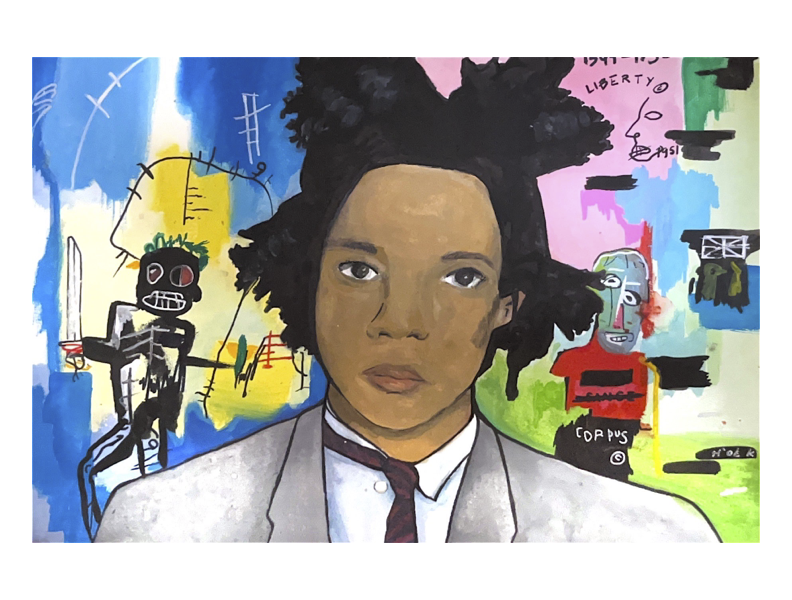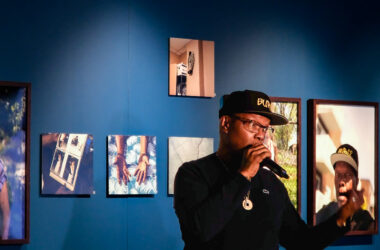After his untimely death in 1988, Jean-Michel Basquiat rose above his hard-earned fame to become one of the most celebrated neo-expressionist artists of the 20th century. His works grew in popularity, and now, Basquiat’s designs can be found around the world, from sneakers to album covers.
His fame has also meant the simplistic reduction of his image to that of a primarily visual artist, when in fact, he was also a musician and performance artist. Yet, Seeing Loud: Basquiat and Music, a new exhibition at the Montreal Museum of Fine Arts (MMFA), synthesizes the many creative aspects of Basquiat into an unprecedented portrait of the artist himself.
Seeing Loud is a collage of drawings, paintings, performances, music, and more that tracks Basquiat’s artistic career in seven sections. There is special emphasis on Basquiat’s involvement in the experimental, multi-genre band Gray, which he co-founded with filmmaker Michael Hoffman in 1979.
The exhibition focuses mainly on the essential connection between Basquiat’s fine arts and music, highlighting both the music he created and that which inspired him. Many of his pieces include written words and onomatopoeia; the forms depicted capture and mirror elements of his musical aspirations.
As guest curator Dieter Buchhart said in a press release, “Basquiat’s works appear like a ‘language of rupture,’ a concrete poetry of hip-hop created in a copy-and-paste technique and jazz improvisation. Music thus forms the decisive link in his art.”
The visitor’s experience begins in a room displaying many of his paintings, drawings, and a film of various underground music performances in New York City, where Basquiat grew up and cultivated his artistic career. The raw, rebellious sounds of punk shows work in perfect dialogue with his pieces that challenge the status quo, making the connection between Basquiat’s vision and music immediately evident. As the exhibition continues, it becomes clear that music and the themes of Basquiat’s works, many of which speak on various aspects of the Black experience, are not only connected but inseparable.
After a trip to the Ivory Coast in 1986, Basquiat acquired many traditional instruments, such as water drums, castanets, and rattles, which greatly inspired his work. The legacy of the African diaspora and its connections to the “American” forms of Creole and jazz music are central to many pieces in section six of this exhibit, Basquiat and the Music of the Black Atlantic. Basquiat understood jazz music in its greater historical context, demonstrated by the motifs he employed. He often painted African-American jazz musicians who faced racism in the industry to reflect the racial, social pressures he faced after becoming a public figure.
The last section of the exhibit is dedicated to just two of Basquiat’s paintings: Eroica I and Eroica II, created in the last year of his life. They stand out as the perfect example of theme and music converging in Basquiat’s work. They are based on Beethoven’s Symphony No. 3, which shares the same title, Eroica, meaning “heroic” in Italian. With Basquiat’s choice of words and design, the paintings are a poignant monument to the perils and complexity of Black celebrity and commodification.
A great deal of thought was put into this exhibition’s curation, down to the smallest detail. It has a uniquely immersive atmosphere thanks to the constant presence of music, whether it be punk, jazz, hip-hop, or opera. The MMFA collaborated with a Montreal-based studio to create an interactive app that allows the user to experience Basquiat’s art in concert with augmented-reality stage reconstructions and specialized musical selections. In addition, there is extensive associated programming, with events such as film screenings, themed evenings, and concerts being offered throughout the exhibition’s stay.
It is amazing to witness Basquiat’s legacy being remembered in its full scope. This is truly an exhibition whose ingenuity matches that of the artist himself.
Seeing Loud: Basquiat and Music is on display at the Montreal Museum of Fine Arts until Feb. 19.









